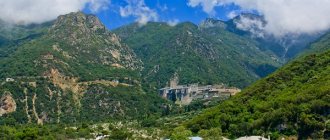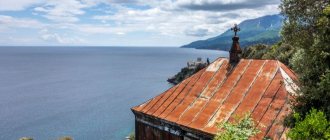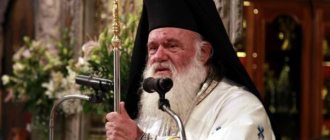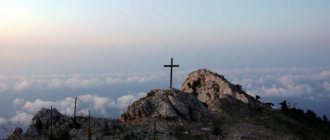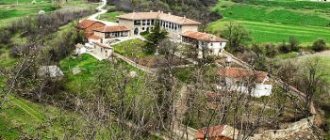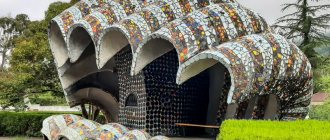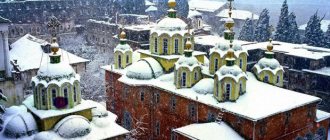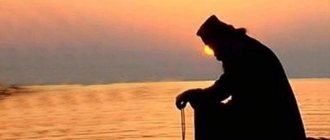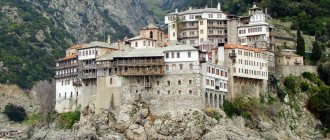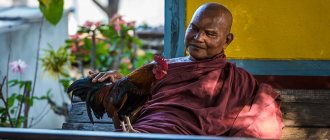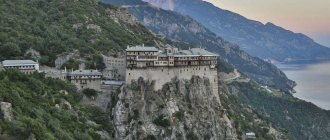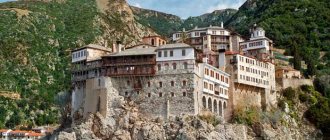A peninsula is located in the waters of the Aegean Sea in eastern Greece. Its highest point, Holy Mount Athos, is considered a symbol of Orthodox monasticism. There are 20 monasteries on the peninsula, living according to their own laws. A new day here begins at sunset, and women are still prohibited from appearing on the sacred land.
Athonite monks
The monks of the Holy Mountain are citizens of the Greek state. Foreign monks who come here from other countries and are foreign nationals automatically receive Greek citizenship. All monks are exempt from military service.
Every Orthodox Christian who is over 18 years old can become a monk. To do this, he needs to come to the monastery that he has chosen and appear before the abbot to declare his voluntary desire to devote himself to monastic life.
In special monasteries, you can appear before the observer or manager of the monastery. In this case, the young man becomes a novice not of the monastery itself, but of its manager. You can also declare your decision to the elder of any dependent institution. In any case, from this moment the person becomes a novice. The period of obedience, according to ancient traditions, should be 3 years, but today it is limited to two years or one year. The novice wears a cassock with a leather belt and performs the work assigned to him. The main task of the elder or manager of the monastery is to prepare the novice for the common life of monks and dedication to God.
After the end of the period of obedience, if the novice is firm in his decision and is considered worthy by his spiritual leader, the clergyman calls him to the temple of the monastery or dependent institution, says a prayer and cuts his hair. Such monks are called ryassophores and represent the first degree of monasticism. They can still return to mundane life without much consequence. Those who wish can continue their spiritual path and receive the official blessing of the minor schema. The ryassophore monk enters the royal doors, where he appears before the abbot and declares his desire to continue his monastic path. He takes a vow of celibacy, poverty and obedience, after which he undergoes another rite of tonsure.
Now the monk is forever lost to the world, as a sign of which he loses his last name, as a connection with his family, and replaces it with the name of the monastery. The monk leaves only the first letter of his personal name.
The three main vows of a monk are closely related to the three main virtues: celibacy, obedience, poverty. Violation of the requirement of celibacy is punishable by loss of monastic rank. The monk must obey the elder and the leadership of the monastery in everything and unquestioningly follow all their instructions; in case of non-compliance, appropriate punitive measures are imposed. The vow of poverty concerns the time after entering the monastery, i.e. if the monk previously had his own property, which he received by inheritance or in some other way, this rule does not apply to it, but it is assumed that the monk will dispose of his property in accordance with Christian principles. The property transferred to the monk after tonsure is given to the monastery upon his death.
The tonsure of a monk today has rather a symbolic meaning, but previously monks cut their hair regularly, and only those who were punished for their disobedience, or wandering monks, remained unshorn.
The third degree of monasticism is the Great Schema, intended for the few who accept it in old age, because it presupposes the strictest asceticism. The schema-monk's vestment consists of an analava (a small quadrangular cloth made of cloth with an image of an eight-pointed Orthodox cross at the foot) and a kukol (a monastic head cover similar to a hood). Today the Analav is worn less and less often, and the headdress is constantly worn in the temple and in the refectory.
Monks ordained into the church camp do not represent any separate class of monasticism. Only monks from the Holy Mountain can receive ordination on the Holy Mountain after the decision of their monastery, but laymen and monks from territories outside the Holy Mountain are deprived of this opportunity. The ordination is performed by a bishop who is invited here specifically for this purpose.
Hegumen - partisan
Father Herman Dimakis, nicknamed Pope the Impatient, became the most famous partisan monk. He fought and simultaneously served as a military chaplain in the Greek People's Liberation Army.
It was the army commander Aris Velouchiotis who gave Father Herman the nickname for his courage and constant desire to fight. Father Herman was born in 1912 and received the name Georgios at birth, and was named Herman when he was ordained as a deacon.
By the beginning of the Italo-Greek War, which began World War II for Greece, Herman was already abbot of the Agathon monastery in Ipati, in the Phthiotis region. When the German-Italian-Bulgarian occupation of Greece began, Father Herman joined the pro-communist National Liberation Front, and in 1943 he met Velouchiotis and joined the partisans. He summoned the metropolitans of Kozani, Joachim and Elis Anthony, who were persecuted by the Nazis.
When the British entered Greece and de facto seized power, the People's Liberation Army deployed weapons against them. Soon the government of Plastiras was formed, with which the liberation movement concluded the Varkiza Agreement on a ceasefire and disarmament. The patriotic left has been deceived. Right-wing monarchists immediately began to persecute them. In 1946, during the White Terror, Father Herman was tortured by right-wing gangs, then the Black colonels persecuted him for his connections with the communists, but with God’s help, Father Herman lived for 92 years and died in 2004 in the city of Lamia.
See also: Contouring: how to change your face shape without makeup and revitalize your hair without scissors
Life of monks on Athos
There are several ways to tell time on Mount Athos. The cinemas, monasteries and institutions dependent on them follow the old Julian calendar, while the Patriarchate adopted the revised Gregorian calendar about 60 years ago.
Regarding clock time, the monasteries of Vatopedi and St. Panteleimon, as well as state and secular services, follow the usual daily routine here, with the day starting at midnight. The monastery of Iveron counts its day at sunrise, while the other 17 monasteries, like Kinot, follow the Byzantine clock, according to which the day begins at sunset. Of course, in theory, these monasteries should change the hands of the clocks every day, as well as every week, in order to begin their report from sunrise or sunset.
The day of a monk’s life on Mount Athos is divided into three parts of 8 hours each, the first of which is devoted to prayer, the second to work and the third to rest. However, some activities - such as studying sacred texts - can take more than 8 hours and involve prayer, rest and work at the same time. Meal time is usually included during rest periods.
Below is the program of monasteries of 2 types, translated into secular hours.
How does modern science explain the phenomenon of longevity of monks?
Photo: Flickr.com
The study of the causes of longevity is carried out by worldly scientists, for whom the explanation of the Divine will and God's special favor towards monks is not a sufficient argument.
Thus, a professor at the University of Thessaloniki in Greece, Charalambos Aidonopoulos conducted a study of the lifestyle, diet and daily routine of the Athonite monks. In addition, the object of the professor’s research was the diseases that monks suffer throughout their life in the monastery. As a result of long-term observations, he wrote a report to speak at the medical conference “Health and Diet.” In his speech he emphasized:
“The traditional diet and daily moderate lifestyle of the monks, combined with physical labor and regular prayer, leads to the fact that cancer is very rare among them.”
In addition, the scientist agrees that a clear mind and physical activity up to the age of 90 are given to monks due to the fact that they are isolated from the world, live according to a strict schedule and observe chastity. After all, entry to Mount Athos is still prohibited for women. Residents of the Holy Mountain are very active, travel on foot, do a lot of physical work and pray a lot. And this way of life, combined with a favorable climate, gives them advantages over those who live in the same climate but are subject to harmful habits.
Time of Saint Athos, schedule of life of monasteries
Cenobitic monasteries
| Midnight | Climb |
| 00:05 — 01:00 | Canon (300 bows) |
| 01:00 — 04:00 | Matins service |
| 04:00 — 05:30 | Rest |
| 05:30 — 06:00 | Climb |
| 06:00 — 07:30 | Service |
| 07:30 — 08:00 | Shared meal |
| 08:00 — 12:00 | Obedience |
| 12:00 — 14:00 | Rest, reading |
| 14:00 — 15:30 | Obedience |
| 15:30 — 16:30 | Vespers |
| 16:30 — 17:30 | Shared meal |
| 17:30 — 18:00 | Free time |
| 18:00 — 18:30 | Closing the gate/night prayer |
| 19:00 — 24:00 | Dream |
Special monasteries
| 04:00 | Climb |
| 04:10 — 06:30 | Matins service |
| 06:30 — 07:00 | Private dining |
| 07:00 — 10:00 | General obedience |
| 10:00 — 12:00 | Private obedience, reading |
| 12:00 — 13:00 | Private lunch |
| 13:00 — 15:00 | Rest |
| 15:00 — 16:00 | Vespers and Compline |
| 16:00 — 18:00 | Monastic obedience and free time |
| 18:00 — 19:00 | meal |
| 19:00 — 21:00 | Reading |
| 21:00 — 22:00 | Canon in private |
| 22:00 — 04:00 | Dream |
Divine service
The prayer of monks, like all other Orthodox Christians, is divided into private and general.
The basis of private prayer is the mention of the name of the Lord: “Lord Jesus Christ, have mercy on me a sinner.” In communal monasteries, prayer is performed by all the monks gathered for this in the main temple, but silently. In special monasteries, this prayer can be performed both privately and in a general meeting. In general, monks of special monasteries have greater freedom. Regardless of whether this prayer is performed in a temple or in a cell, it inspires the soul of a monk, soaring to transcendental heights, if it is pure. This is a silent, hesychast prayer.
Daily congregational prayers include prayers at dawn, lunch, sunset, midnight, as well as at the following hours: one, three, six, nine, and prayers at the service. All of them take place at night, i.e. during the hours when the laity indulge in rest. On holidays, the program changes radically: even more time is devoted to prayer. On great holidays, of which there are about 50 a year, 15 hours are allotted for continuous prayer, starting at 8 pm and ending at 11 am the next day.
Requiem services are celebrated in all monasteries during holidays or commemoration of great saints. A panegyric, or festive service, is performed in memory of persons or events to which each monastery, monastery or cell of the Holy Mountain is dedicated, as well as some of the saints who monasticated here. There are more than 240 Svyatogorsk martyrs and saints.
The Svyatogorsk musical tradition has its roots in the distant past, and owes much to John Koukouzelis, who served at the court of the Byzantine emperor but, disillusioned with worldly life, arrived on Athos around 1300. Here his musical talent was appreciated, and he recorded new melodies. Here, on Athos, like in no other church center, true Byzantine music has been preserved. It is practiced in some cells at the end of the peninsula. Listening to the choral singing of monks to Byzantine melodies is an incomparable pleasure.
The surroundings of the monastery church, its entire structure, its sophisticated lighting, its sacred frescoes, as well as the monastic perception of life, which is timeless, elevate monks and lay visitors above all earthly things.
It should be noted that the monks especially venerate the Blessed Virgin Mary. Each monastery can tell its own legend or tradition about the unprecedented care that She showed in relation to the temple, chapel or the entire monastery. Many monasteries have Her miraculous icons. The monks themselves call the Holy Mountain the garden of the Mother of God and consider Her to be its queen. This is the only woman for whom there is a place on Athos.
Monasteries of Meteora
Of course, monks from the hard-to-reach monasteries of Meteora could not help but participate in the Resistance. From the very first days of the Greco-Italian war, the monks began supplying, financing, sheltering, and treating active fighters. Some monks and novices joined their ranks.
See also: There are downsides to visiting a jacuzzi
The largest monastery, Megalo Meteoro, has a Museum of the Resistance in the former refectory, which tells the story of the heroism of the monks during the Second World War. The monasteries suffered from raids and bombings by the Nazis, who, not without reason, suspected the monks of collaborating with the partisans. The Monastery of St. Stephen, which is the most accessible of the entire rocky monastery area, was especially hard hit.
Reading
“Write, read, sing, sigh, be silent, pray.” Many pilgrims are surprised and even express these surprises in writing in their notes, but on Athos they really read a lot, some with particular passion, because reading is the only substitute for the outside world, which the monks have abandoned. One way or another, reading is a continuation of prayer, just like writing. When monks write, they pray; They also indulge in fervent prayer when they practice calligraphy. It should be noted that the word “write” has little to do with writing, because It's hard to imagine that all monks are excellent writers. Of course, we are talking about a census of books.
Reading is provided even during meal hours. In such cases, the lives of saints, panegyrics and some other books of the church fathers are read. The personal libraries of monks are always decorated with the Holy Scriptures and the works of the holy fathers. It is not enough for monks to use the Holy Scriptures only in worship - they also study it privately. Some know the contents of the Old and New Testaments by heart. The monks also study the latest theological and philosophical works, and only a few of them read books of other content. However, fiction can also be found in local libraries. Because monastic life is considered the next stage after the worldly, then literature related to the world ceases to be of interest to the monk, although reading it is not prohibited.
Escape to Athens
The heroism of the Greek monks is also depicted in the famous film “Flight to Athena” with Roger Moore. It tells the story of Allied prisoners of war in a camp on a Greek island engaged in archaeological excavations. Against the Germans in the film are the monk Zeno and his resistance fighters. They use a local brothel as cover. Zeno is also in touch with the Allied headquarters (by the way, one of the monasteries of Crete - Kapsa - was used as the main radio communication point for the Allies). He is tasked with organizing an uprising in the camp, which he does, but the help of the allies is delayed, and he and the liberated people must capture the garrison on Mount Athena. The monk heroically performs a most difficult task.
source
If you find an error, please select a piece of text and press Ctrl+Enter.
Obedience
Everyone on the Holy Mountain is working. Ascetic monks in their cells are busy, as a rule, engaged in agriculture, winemaking and other work, while the inhabitants of the Kalivas and Hesychastirites are busy with manual labor, i.e. production, for example, of wood carvings. Some cells are closely associated with art and have reached great heights in music and painting.
Monastery servants perform work related to all aspects of the life of their monasteries, as well as worship, maintaining relics, serving the brotherhood and pilgrims, cultivating gardens and caring for trees. It should be noted that the decrease in the number of monks greatly impedes the completion of the necessary work, and the increase in the number of visitors during the summer months makes this task even more difficult. For this purpose, monasteries with a small number of monks are forced to hire laymen for service - mainly for external work.
Today the following positions are provided in the cenobitic monastery:
- abbot, observer, representative, secretary, librarian, steward, treasurer, sacristan, archivist, deacon, choirboy, reader, candlelighter, tour guide, storekeeper, cook, baker, doctor, night watchman, forester, woodcutter, winemaker, gardener and some others .
Without a doubt, small monasteries do not have the opportunity to appoint one of the monks to each position, so often one person can perform several functions at once. Similar positions are provided in special monasteries.
Nutrition
The strict diet of the Holy Mountain does not differ in variety; The basis of Athonite cuisine is bread, olive oil, wine, olives, and vegetables.
The monks of the cinenial monasteries and a large number of kalivs take food twice a day - in the morning and at lunch - only a few days a week; On Monday, Wednesday and Friday one meal per day is provided. During fasting, monks eat once a day for all of its days. It is also worth noting that food is prepared without the use of oil, which is allowed only on Saturday and Sunday. These monks never eat meat, and only eat fish on major holidays.
The fast of hesychast monks is even stricter. The monastic diet involves maintaining the necessary physical strength, but not gluttony. Monks of special monasteries, cells and a small number of kalivas eat twice a day, also adhering to a modest diet. Eating food in the monastery is a sacred rite, continuing the divine liturgy; that is why the refectories were built in such a way that their entrance was opposite the entrance to the main temple. The monks enter the refectory in a procession, and the main obligatory attributes of each meal are prayer, attention and perception of the texts pronounced by the reader.
Hospitality
All monasteries are essentially charitable organizations or centers of philanthropy. Since the beginning of its creation, the church has always shown concern for the suffering.
Despite the fact that Holy Mount Athos is located far from the world, the latter constantly sends its representatives there. Visitors to the Holy Mountain can be divided into several categories: those who come here for spiritual relaxation, explorers, the curious and just tourists.
These areas can be visited by male laymen. They have the right to live in any monastery, if possible, and to stay on Mount Athos for as long as the Epistasia (special commission) has allocated for this, noting their decision in a residence permit (diamonitirion). The usual length of stay on the Holy Mountain is 4 days. Only Orthodox Christians can come here for permanent work. The list of jobs offered on Mount Athos is not so long: craftsman, builder, farmer, office worker. Limited number of seats. With special permission from the Patriarchate or the Ministry of Foreign Affairs, it is possible for scientists to stay for a longer period of time for research in libraries and archives in churches and other buildings.
Despite the fact that today the monasteries are not so rich, they are ready to provide all the necessary means to show hospitality. The monasteries even have special buildings designed for guests, which are called “archondariki” and are essentially hotels. This is where the pilgrim will stop, where he will be offered a treat: a glass of local wine and some sweets. Here, in the monastery, they will eat and spend the night. From here you can see all the greatness of the nature of the holy mountain, the sea stretched out in front of it and the endless sky.
The concept of hospitality is more than just a table and a place to stay. The monks guide visitors through the buildings, showing holy relics, treasures of the monasteries and their libraries. The monks give the wanderers the most valuable thing they have - their love and care.
#Family#Travel
Russia, Adygea, Khamyshki, Mount Monk, 1062.9m, May 22, 2018
The trail: poorly marked, in some places up to the top and a little on the descent, the transition to the dolmens is not marked at all. Be sure to have a map in your phone. The trail is covered with dirt and, in some places, open rock. Well padded almost all the way through. After the rain the climb will be slippery. Possibly very slippery. Water: there is a spring halfway up the climb and at the top of the grotto. The quality of the water is questionable, it is better to boil. On the way back, water can only be collected at the waterfall, and this is half of the descent. No more water was seen along the route. Take it with you. Poles: trekking poles. For those who are carrying a child, it is obligatory throughout. For the rest, it is recommended when climbing. Transport for the child: carried in a Manduca ergo-backpack (in front) Food: packed lunch for themselves and the child Backpacks: for three of us there were backpacks of 20 liters and 4 liters. Normal configuration for three. No more. Less too. Additional equipment: the ascent and descent are quite steep and can cause trouble even in dry conditions - 20 meters of the main climbing rope (when hiking with a child) will be very useful.
Physical training requirement: the ability to carry a child in a carrier for up to 20 km over rough terrain, plus overcome 450 meters of elevation gain in 3 kilometers.
Evacuation: no people were encountered along the route. Communication is not available everywhere. The descent from the top is much more difficult than the ascent. Or go the entire route.
Track on strava: link Elevation gain: 445 m Distance: 10.7 km Maximum altitude: 1057 m Time: 6.5 hours
At the start, the main thing is to get on the right path. It starts about twenty meters from the asphalt road, in front of the bridge over the Bzykha River (if you come from the Dakhovskaya side). As of May 2018, there was no direct access to the starting point. The technical road marked on the maps has been dug up. Entry is not possible. The car was left on the outskirts of Khamysheki.
The correct path goes up sharply. We unpack the poles and set them up right at the start. If there are no sticks, we immediately cut the beech or hazel into sticks or staves. And forward, upward!
1. Top of the mountain monk. Let's go for it.
After walking the first 80-100 vertical meters, I strongly recommend stopping, listening to yourself and soberly assessing your strength. The remaining 350 meters will be steeper and tougher. Especially if the slope is wet and you are with a child on your back/stomach. But we got through.
The rope (if there is one) should also be immediately moved closer. But the camera can be removed. There is absolutely nothing to photograph until almost the very top. Better focus on getting up
2. First stop
The first stop is a drying stream near a “tree on a stone.” In May it flowed in a thin stream. In June, most likely, there will be no one at all.
3. Tree on a stone
4. Path
The mountain is very green. This is both a plus (it’s not hot) and a minus (you can’t see anything behind the leaves). The mentioned rope may be needed at about the 250th vertical meter. Following the trail you will come across a very smooth rock outcrop. It is not difficult if it is dry and there is no child hanging on you. Otherwise, it is better to use a rope (it’s more reliable), although we were able to do without it (not the most pleasant feeling).
5. At this point we turn off the path to the right
As soon as you see the “cheese” in front of you, you can put the rope in your backpack and take out the camera. There are fifty meters left to the top, but you have already arrived at the beauty.
6. Cheese!
The wall with “cheese” type holes is the most picturesque thing on the route. And the only thing is if you go “to the Monk and back down.”
7. The path to the resting place
Feel free to take off your backpacks - first stop!
8. Under the roots of the tree there is a spring
There is a large enough area around you where you can sit comfortably. There are equipped fire pits, a permanent spring, a bunch of flat stones on which you can sit, lie, or use as a table.
9. More cheese
10. Folk art
It’s especially interesting to look at traces of folk art - the breed is soft, and our man likes to scratch something in his spare time.
But the most beautiful thing is the breed with holes.
11. The most picturesque place on Monk
12. Climbing over pebbles is a pleasure!
13. Types of cheese
14. Traces of reptilians
15. “Russian” cheese!
16. Conditional observation deck
There is a conditional observation deck. You can’t see anything from it at all (don’t count a piece of the village of Khamyshki and the Belaya River as a “view”). Judging by the map, the correct lookout is located about twenty meters higher (but we didn’t see it). It is to it that the well-paved path (well, as in “paved”) goes, which remains on your left hand (you turned off from it).
17. Visual evidence of the existence of reptilians: can right angles themselves form in nature?
We went to look at the “grotto”, that is, to the right along the nominal path and took a fair detour through the bushes. It can be seen on the track.
18. Do you see the path? And she is!
I don't recommend going this route. The path is very conventional, making your way through the bushes is no pleasure, and most importantly, no point.
19. The “grotto” type, which is a fire pit and garbage dump
The grotto is a fire pit and doesn't deserve any attention.
We never found the supposed turn of the path to the observation deck (see track).
We moved in a straight line to the top (according to OSM). Halfway through the journey (you can see the “shaking” on the track) we came across an excellent clearing under beech trees (perfect for setting up camp), where we immediately had a big lunch, which turned into a family council.
20. Any trail requires on-site reconnaissance (even if it is marked on the map as a “motorway”)
Going down the same route was a little stressful. It was very slippery on the path. Four hundred meters down on your butt with a child did not seem like the best entertainment. Oh, if only there was a rope! (it was after this trek that I realized that in the mountains a rope does not pull a backpack, even in Adygea) But there was no rope.
21. On the way to the top
The alternative was to go down through the dolmens (44.12927, 40.09571). The map promised a much flatter descent, the mentioned dolmens, a couple of waterfalls (44.1182, 40.10118) and a detour of ten kilometers.
There is most of daylight ahead. So - we choose a long walk around.
22. The height is taken! But where to now?
But first, check in at the top. It’s downright lazy to hit the mark, especially since we’ve only just found something similar to a trail. We limit ourselves to OSM readings that exceed the height of the mountain (the altimeter on the watch showed 1053 m).
We congratulate each other on the mountain (the child is dozing peacefully after lunch) and... we lose the path. That is, according to the map, we are on it, but in fact we are in the bushes. A little wandering does not bring results. There is no path. We decide to go ahead in azimuth. The landmark is a technical road (it is visible even on satellite images). In 10 minutes the road is...
The further path, about three kilometers to the dolmens, follows the mentioned road, which becomes more and more passable as you approach them. And there’s absolutely a “motorway” right next to them. Once upon a time there were “shishigas” (judging by the ruts), then UAZs. Now the foresters have been transferred to ATVs and horses. Or maybe these are not foresters at all.
23. Dolmens
In the photographs, only a sign remained from the dolmens. The dolmens themselves have nothing in common with the traditional “kennel of stones”. The complex looks like a washed-out cemetery. Stone graves with lids removed. There's nothing to film. Watch without, if I may say so, diving into the topic either.
Please note that the dolmens are located somewhat away from the road. A discreet path leads to them. And the road ends in a large clearing with traces of regular human habitation (fireplaces, traces of tents, a wooden table and a certain amount of garbage). You won't miss. There's a fork there. The service road goes towards the Witch Hill mountain and leads to the Dakhovskaya - Lago-Naki highway. The trail leads back to Khamyshki through the waterfalls. We didn’t see water in the clearing, but perhaps it was there.
Short break. And down the path. Our goal is to descend and loop the route.
From the dolmens to the waterfalls it’s a three-kilometer walk. The trail is good, well-traveled, even quite flat, unlike when climbing Monk, it is not difficult. Almost.
About three hundred meters before the waterfalls (let me remind you that we are going from top to bottom), the slope becomes increasingly steep, and there is a real danger of driving down the slope if you fall. Underfoot, the soil, still wet like May, slides treacherously suddenly.
The speed of movement drops to the level of a sick snail after a heavy lunch. Zaichishkina walks ahead, checking the road. I carry the child, slowly checking every step with a stick. A physically tangible scene of buying twenty meters of the main rope flashes before your eyes... (which will be purchased only in a month...) The daughter finally wakes up and loudly expresses her attitude to what is happening.
Visually, the trail was only visible about twenty meters ahead. It was not possible to find a description of it (except for a mention of its passability to adults) during planning. At some point we stop and seriously consider the possibility of turning around in the opposite direction.
24. For mad tourists with a child, ten miles is not a detour. Wow, we're going down from there!
But there is no particular desire to stomp back to Mt. Monk and go down through it; to go out through Mt. Witch Hill - especially since there is still a lot of time left. But on the other hand, there are rain clouds walking around, the child is capricious and we are already tired of this track (end of vacation).
The map is optimistic, promising a long and gentle descent after the waterfalls, but before them there is still a hundred meters of trail with steep slopes... And then a railing appears from behind the bushes. Yes, not from a rope, but from a fifteen-centimeter steel cable. The descent immediately begins to go much more vigorously. Although somewhere in my head a thought is spinning: don’t such strong railings indicate something completely impassable with a child? Fortunately, no, they don’t. (It’s good to have after-knowledge).
25. Nameless waterfall on a nameless stream
Afterthought: Sections with railings on the descent are no different in steepness from the previous ones, but with railings the movement is easier and safer. There is no tin on the trail. But there really is a section (about 350 meters long) where it can be very unpleasant to drive down the slope even without a child. About half of the path has railings, the other half does not, but this is not such a problem when walking on dry ground (if you have poles). In the wet with a child in a carrier - I would not refuse to move in a simple connection, without a safety system (Just to be able to quickly brake on a slope without injury to the child in case of slipping).
26. Descent (at the fifth point)
We quickly walk along the railings to the observation deck of the waterfalls (from which we can’t see anything at all). The path suddenly ends - a slope collapse. There are no railings. There are only exposed tree roots and loose soil. The slope is quite steep; riding it on your butt with a child is not the best idea. We had to go down as far as possible along the roots of the tree. Then turn around and ride on your butt the rest of the way, braking yourself with a stick. Nothing like that, but the ground is wet and slippery. If you climb this section with a child, problems may arise without a rope - there are few good holds, and getting to them with a shifted center of gravity is not easy.
27.
28. Zaichishkina now has her own waterfall. Let it be her name, although no one except us suspects it.
We take a well-deserved break at the waterfall. Zaichishkina is glad that we finally came across “a real waterfall, and not big rapids.” My daughter is captivated by the waterfall. Without ceasing to point at him with his hand and say “Wa!” (which means “waterfall” - one of her first words not related to mom and dad).
The stream at the foot of the waterfall is easy to cross over the rocks. On the other bank we find a continuation of the path, which after fifty meters turns into a road of the “jeeper’s dream” type, and then into a simple black primer “goodbye suspension”. Along it you have to cover three kilometers of gentle descent.
29. Zaychishkinsky waterfall
We jump out into a clearing under the power line and an even more well-trodden road along it. We move along the clearing to the left, the roofs of the village of Khamyshki will be visible in literally 5 minutes.
The path to the village is blocked by the Bzykha River. In May it was quite deep, but not deep. We forded it (just above the knee). To the left along the bank (downstream) there is a bridge for pedestrians - a path leads to it, which is not very visible from the road, but it is there.
Another fifty meters ahead and we reach the starting point (the Dakhovskaya - Guzeripl highway).
Results to conclusions:
- The route is quite passable with a child
- poles are a must
- walking with a rope will be much calmer and easier
- beauty along the route is presented at exactly two points (waterfalls and “cheese”),
- which are quite far apart from each other.
- the points can be taken independently of each other and not make a circle.
- Descending with a child from the top of Monk without a rope may be unsafe
Share link:
Liked this:
Like
